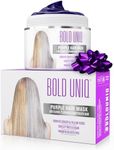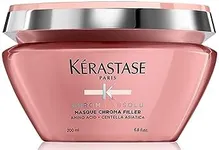Buying Guide for the Best Damaged Hair Treatments
When choosing a treatment for damaged hair, it's important to understand the specific needs of your hair type and the extent of the damage. Damaged hair can result from various factors such as heat styling, chemical treatments, or environmental exposure. The right treatment can help restore moisture, strength, and shine to your hair. Consider your hair's texture, porosity, and the type of damage it has sustained to select the most effective treatment. Always look for products that are designed to address your specific hair concerns and are formulated with ingredients that promote hair health.IngredientsIngredients are the active components in hair treatments that work to repair and nourish damaged hair. This spec is crucial because the right ingredients can significantly improve the health and appearance of your hair. Common beneficial ingredients include keratin, proteins, oils (like argan or coconut), and vitamins. If your hair is severely damaged, look for treatments with proteins and keratin to strengthen and rebuild hair structure. For dry or brittle hair, moisturizing oils and vitamins can help restore softness and shine. Choose ingredients based on your hair's specific needs and any sensitivities you may have.
Type of TreatmentThe type of treatment refers to the form in which the product is applied to the hair, such as masks, leave-in conditioners, or serums. This is important because different types of treatments offer varying levels of intensity and convenience. Hair masks are typically more intensive and are used less frequently, making them ideal for deep conditioning. Leave-in conditioners are lighter and can be used daily for ongoing moisture and protection. Serums are great for targeting specific areas like split ends or frizz. Consider how much time you can dedicate to hair care and the level of damage when choosing the type of treatment.
Hair Type CompatibilityHair type compatibility ensures that the treatment is suitable for your specific hair texture and condition. This is important because a product that works well for one hair type may not be effective for another. Hair types can range from fine to thick, straight to curly, and each has unique needs. For example, fine hair may require lightweight products to avoid weighing it down, while thick or curly hair might benefit from richer, more hydrating treatments. Assess your hair type and look for products specifically formulated to address its unique characteristics.
Frequency of UseFrequency of use indicates how often a treatment should be applied to achieve the best results. This is important because overuse or underuse can affect the effectiveness of the treatment. Some treatments are designed for daily use, while others are meant to be used weekly or bi-weekly. If your hair is severely damaged, you might need a more frequent treatment initially, then reduce usage as your hair improves. Always follow the manufacturer's recommendations and adjust based on how your hair responds to the treatment.
Sulfate and Paraben-FreeSulfate and paraben-free products are formulated without these potentially harsh chemicals, which can strip hair of its natural oils and cause further damage. This spec is important for maintaining the health of your hair and scalp, especially if your hair is already damaged. Sulfates can be too harsh for delicate or color-treated hair, while parabens have been linked to various health concerns. Opting for sulfate and paraben-free treatments can help preserve your hair's natural moisture and prevent additional damage. If you have sensitive skin or are concerned about chemical exposure, this is a key factor to consider.















